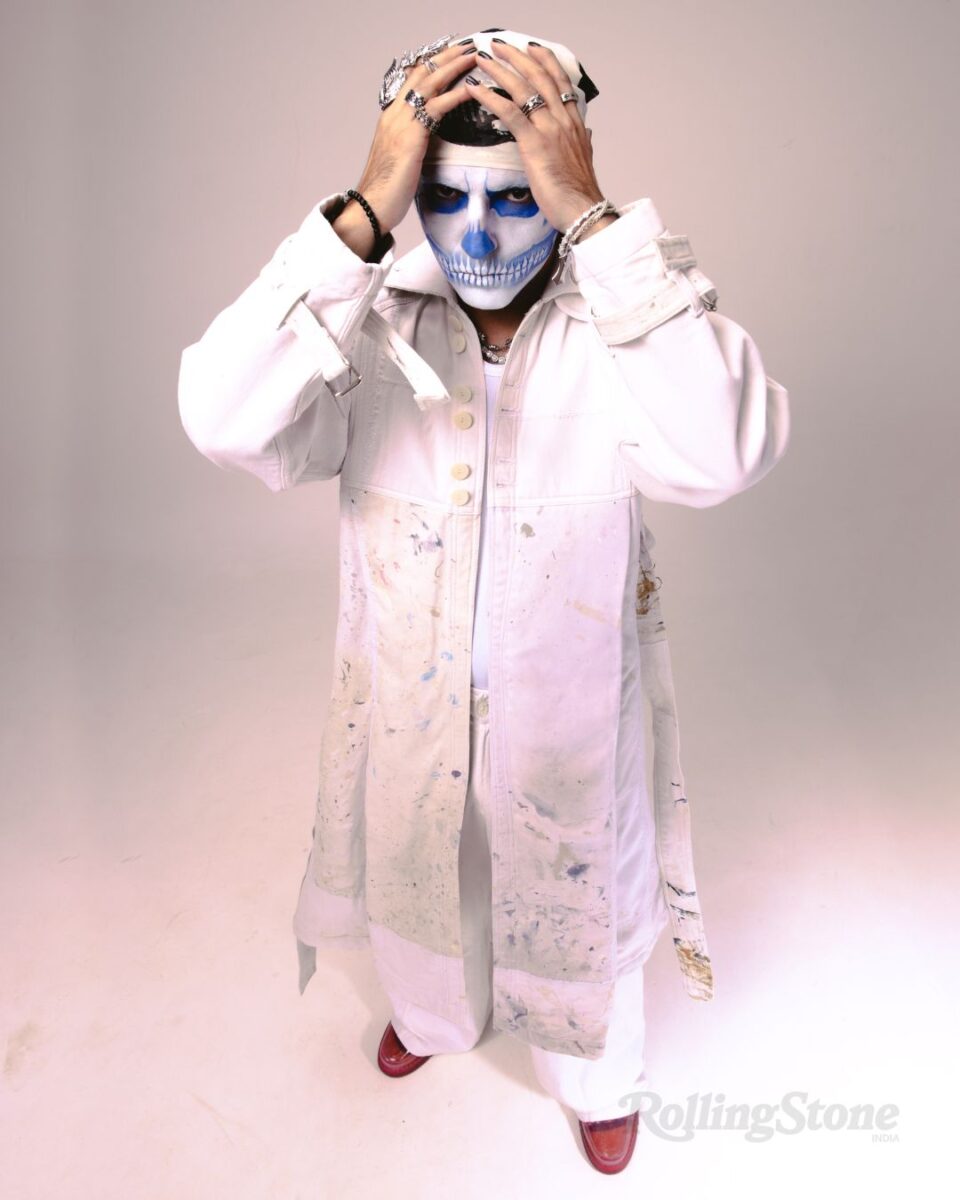
COVER STORY: Talwiinder Was Born to Stand Out
The Punjabi artist demonstrates that musicians can thrive by defining their own paths
It’s late evening in Mumbai, and Talwiinder, one of the most elusive and intriguing artists in the Punjabi music scene, is seated across from me in the studio where we’d been shooting his cover looks and a music video for the past 10 hours. Dressed in a green vest, with his signature mask obscuring much of his face, he exudes an air of quiet confidence. He’s soft-spoken, thoughtful with his words, and magnetic, even though much of his life remains a mystery. Unlike many of his contemporaries, Talwiinder has chosen to shun the spotlight that comes with fame, instead letting his music speak for him. And it’s working—his sound, a mix of Punjabi roots and modern, global influences, has garnered him a loyal fanbase.
Talwiinder’s (full name: Talwinder Singh Sidhu) impact is undeniable. With over 100 million streams across platforms such as Spotify and YouTube, the 26-year-old singer’s tracks have captured the attention of listeners worldwide. His verse on Hasan Raheem’s hit song “Wishes” skyrocketed to the top of the Punjabi music charts, amassing millions of streams and cementing his place in the industry. His 2018 track “Unforgettable” follows closely behind, becoming an anthem with its hypnotic beats and reflective lyrics, propelling him further into international recognition. Today, Talwiinder competes as one of the most streamed independent Punjabi artists, yet he remains as grounded and humble as the day he started.

“I started singing when I was about three or four years old,” he tells me with a hint of nostalgia in his voice. “I grew up in a small village called Tarn Taran, near Amritsar. Back then, I wasn’t thinking about becoming an artist; it was just something I loved to do.”
He pauses, adjusting his mic slightly, as though he’s still adjusting to the idea that people care about his story. For Talwiinder, music has always been a personal journey, not a path to fame. “There was this kid in our neighborhood,” he continues, “and he used to sing really well. People would compliment him, and I guess, being a kid, I felt a little jealous. I remember thinking, ‘I can do this too. This isn’t rocket science.’” He chuckles at the memory, and it’s in that moment that I realize how deep his connection to music runs. It wasn’t about proving something to others—it was always about proving something to himself.
But that desire to match the neighborhood singer was just the beginning. Talwiinder started singing at every school function, cultural event, or local gathering he could find. It wasn’t a calculated move to get attention; rather, it was pure passion. “Singing was just a part of me. I didn’t even realize it was something I could do professionally until much later.”

His tone shifts slightly as he reflects on those early days in Punjab. Growing up in the heart of the region, Talwiinder was surrounded by traditional Punjabi music, an influence that is still very much present in his work today. His grandfather, a Punjabi teacher, had a big impact on him, and he recalls listening to the likes of Surinder Kaur and Nusrat Fateh Ali Khan during his childhood. This love for the Punjabi language became the foundation of his career, even as he found himself influenced by artists such as Bad Bunny, who sings in Spanish without catering to English-speaking audiences. “I never wanted to box myself in,” he explains. “Punjabi music has such a rich history, and I wanted to honor that. But at the same time, I’m also influenced by so many other genres. I wanted my music to be a bridge between my roots and the wider world.”
“Even though I can rap in English or Hindi, it wouldn’t feel real,” Talwiinder says. “With Punjabi, I’m at my best. I felt like I had to change the state of Punjabi music when I was graduating [college] because it wasn’t doing justice to the language’s richness.”
It’s an ambitious vision, but one that Talwiinder has executed with remarkable finesse. Tracks such as “Khayaal,” which has over 60 million streams on Spotify alone, and “Nasha” with more than 18 million, perfectly showcase his ability to merge these seemingly disparate worlds. The former is a smooth, melodic piece, while the latter features a more modern, R&B-inspired beat. “I wanted people to hear my music and know that it’s Punjabi,” he says. “But I also wanted them to realize that it’s something new, something different.”
As his catalog grew, so did his fanbase. Tracks like “Tu” and “Aag Banke” became sleeper hits, further bolstering his reputation as an artist who wasn’t just popular in India but had crossover appeal globally. Today, his monthly listeners on Spotify alone hover around the 4 million mark, a result of how far his sound has traveled.

Part of what makes Talwiinder so compelling is his refusal to comply with the typical image of a celebrity. Where others flaunt their lifestyles on social media, he remains mostly anonymous, choosing to keep his personal life entirely separate from his public persona. This isn’t just a gimmick—it’s an essential part of who he is as an artist.
“I want to be an artist, but I also don’t want to give up my regular life,” he says, leaning back in his chair. “I like being able to walk down the street without people recognizing me. I don’t want my face to be what people focus on. It’s about the music.”
The face paint and mask, he tells me, are not about hiding. It’s about maintaining a boundary and preserving a sense of normalcy in a world that often blurs the line between public and private life. For Talwiinder, that boundary is crucial. “I’m just a regular guy. I love going out to eat pani puri, I hang out with my friends, and I live a normal life. I don’t want to lose that.”
There’s a certain irony in Talwiinder’s desire for anonymity, given how personal his music is. His lyrics often reflect his own experiences, struggles, and emotions, offering listeners a glimpse into his inner world—whether it’s his life, his friends’ lives, or his parents’. “Everything is pretty real,” he explains. “I’m just a regular person off stage, so I get to be around people and hear their stories. If I can relate to what they’re going through, I take it upon myself to write about it.” Writing is an intensely personal experience for him, and he takes pride in the fact that he writes most of his material himself. “There’s a misconception that I use ghostwriters,” he laughs, dispelling the rumor. “My friend Rippy has written two or three songs for me, but other than that, it’s all me. If I’m singing somebody else’s lyrics, it feels fake. I owe it to my audience to be as real as possible.” He even recalls times when he was writing 10 or 11 songs a day.

One of his most personal tracks, “Wishes,” exemplifies this genuineness. The verse on the song was inspired by a period of inner conflict, where half of his heart wanted one thing, and the other half was resisting. “That’s what the song is about. I’m sure others can relate to that inner conflict, which is why it blew up,” he says. Even without a big marketing push, “Wishes” gained momentum through word of mouth, proving that honest music related with listeners more than a carefully constructed strategy ever could.
When asked about his creative process, Talwiinder lights up. “Every song is different,” he says. “Sometimes, I’ll start with a melody, other times it’s the lyrics that come first. But one thing that’s always consistent is the collaboration. I can’t take credit for everything; there’s a whole team behind the scenes that makes this possible.” He’s particularly quick to praise his longtime collaborator, NDS, who has played a pivotal role in shaping his sound. “NDS is like my brother,” Talwiinder says warmly. “He understands my vision, and we have this unspoken connection when it comes to making music. It’s a team effort, and I wouldn’t be where I am without him and the other producers I’ve worked with.”

Talwiinder’s appreciation for collaboration is one of the things that sets him apart in an industry that often prioritizes individualism. For him, success isn’t just about the artist—it’s about the entire team working behind the scenes. “I think it’s important to give credit where it’s due,” he says. “The producers, the sound engineers, the people who make the music come alive—they don’t always get the recognition they deserve, and I want to change that.”
As we talk about his journey so far, it becomes clear that Talwiinder’s path to success hasn’t been easy. He vividly remembers the first time he set foot in a studio and recorded his own voice. “That was a turning point for me,” he says. “Hearing my voice recorded was a surreal experience. That’s when I realized, okay, we’ve got something here. We can work with this.”
Despite the challenges, Talwiinder has never been one to give up. His journey from a small village in Punjab to the global stage has been driven by a relentless passion for his craft. But it’s not just about the music for him—it’s about staying true to himself, and to his values.
“I don’t want to be famous just for the sake of being famous,” he tells me earnestly. “I want to make music that resonates with people, that makes them feel something. And if I can do that without having to give up who I am, then that’s all I need.”

He’s set to release his upcoming album, Misfit (via Mass Appeal), entirely produced by NDS, and fans are buzzing with anticipation. The album features a range of both established and up-and-coming talents, including Supreme Sidhu, Kidjaywest, and Amari, among others. “I listen to the art first,” he says, explaining how he chooses collaborators. “If I like what someone is doing and see a bit of myself in their work, I’ll reach out. I want to be that person who helps others the way I wish someone had helped me when I was starting out,” adding, “Misfit is about not fitting into a mold. It’s about embracing who you are, flaws and all.”

The title of the album seems fitting for an artist who has always marched to the beat of his own drum. Talwiinder has never been one to conform to the expectations of the industry, and that’s precisely what makes him so refreshing. In an age where image often takes precedence over substance, he remains committed to his art, refusing to compromise for the sake of fame.
As we wrap up our conversation, I ask Talwiinder what he hopes people take away from his music. He pauses for a moment, thinking carefully before responding. “I just want people to feel something when they listen to my music,” he says finally. “Whether it’s happiness, sadness, nostalgia—whatever it is, I want it to resonate with them on a deeper level. If I can do that, then I’ve done my job.”

In many ways, Talwiinder is a paradox. He’s an artist who thrives on anonymity, a global star who still sees himself as a small-town boy from Punjab. But perhaps it’s this duality that makes him so captivating. He’s a reminder that in a world obsessed with image, it’s still possible to succeed on your own terms.
As I watch him get up and thank the crew, it strikes me just how uncommon that kind of humility is. Talwiinder may be a mystery, but his music is an open book—one that millions of fans around the world can’t wait to keep reading.
Cover Credits
Writer: Peony Hirwani
Photographer: Samrat Nagar
Art Director & Stylist: Suprit Parulkar
Makeup Artist: Ajay Satpute
Videographer: Tenzin Kelsang
Production Manager: Bhavya Vaity
Assistant Stylist: Siddharth Parulkar
Photo Assistant: Suraj Agaarwal
Dressman: Mithun Kumar Saw







